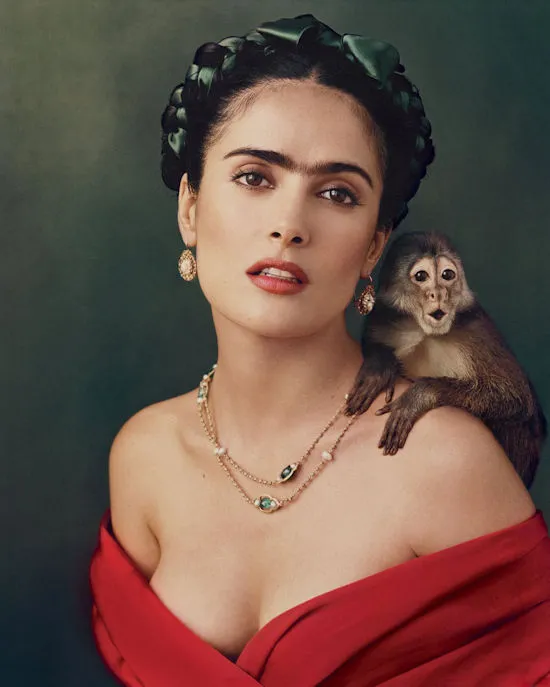Salma Hayek has long been recognized for her powerful screen presence, but her transformative role in the 2002 film Frida marked a defining moment in her career. More than just an acclaimed biopic, Frida is a bold tribute to Mexican artist Frida Kahlo’s life, love, pain, and unapologetic individuality—brought to life by Hayek’s fearless performance and vision.
The Artistic Vision Behind Frida

Directed by Julie Taymor, Frida is not a traditional biographical film. It’s a visual and emotional journey through the life of Frida Kahlo—an artist who turned personal pain into political and cultural expression. The film masterfully blends surrealism, fantasy, and realism, echoing the visual language of Kahlo’s own artwork.
Rather than present a straightforward timeline of Kahlo’s life, Taymor infused the film with dreamlike transitions and symbolic imagery that mirrors Kahlo’s struggles, passions, and rebellious spirit. This bold direction elevated Frida into a cinematic work of art in itself.
Salma Hayek: More Than the Lead Actress
Hayek’s role in Frida extended far beyond acting. She was also a producer, and her commitment to bringing Kahlo’s story to the screen was relentless. In the face of industry skepticism, Hayek fought for creative control and cultural authenticity, determined to portray Kahlo’s story with the respect it deserved.
Her passion stemmed from a deep personal connection to the artist. Hayek admired Kahlo not just as a fellow Mexican woman, but as a symbol of strength, independence, and artistic integrity. That admiration became the foundation for one of the most iconic performances of Hayek’s career.
Video:Top 50 Sexiest Salma Hayek Pictures (MiniList)
Becoming Frida: A Physical and Emotional Transformation
To accurately embody Kahlo, Hayek underwent a dramatic physical transformation. She adopted the artist’s signature unibrow, traditional Tehuana dress, and bold accessories—capturing not just Kahlo’s outer appearance but her defiant identity.
However, it was Hayek’s emotional depth that made the performance unforgettable. She channeled Kahlo’s intensity, vulnerability, wit, and unwavering spirit. Through meticulous research—including studying Kahlo’s paintings, letters, and personal history—Hayek crafted a portrayal that was as intellectually profound as it was emotionally raw.
Her performance earned her an Academy Award nomination for Best Actress—making her one of the few Latina women ever nominated for the honor.
A Visually Stunning Tribute to Frida Kahlo’s Inner World

What makes Frida particularly unique is how it incorporates Kahlo’s art directly into the storytelling. Taymor’s direction frequently transitions between real-life events and painterly scenes that echo the emotions captured in Kahlo’s most famous works.
These surreal, often magical elements were paired with a rich color palette that brought Kahlo’s world to life. Scenes of pain, love, and revolution were woven together with symbolic visuals that left lasting impressions on audiences.
The film’s soundtrack, composed by Elliot Goldenthal, added another layer of emotion. By blending traditional Mexican music with original orchestral pieces, the score amplified the film’s cultural richness and emotional weight—earning an Oscar for Best Original Score.
The Complex Love of Frida and Diego Rivera

A central thread throughout Frida is the passionate and turbulent relationship between Frida Kahlo and muralist Diego Rivera, portrayed by Alfred Molina. Their bond—both romantic and artistic—was filled with admiration, betrayal, loyalty, and pain.
Hayek and Molina’s chemistry captured the complexity of their relationship. Rather than idealizing or simplifying their connection, the film portrays their partnership as a collision of two strong, flawed individuals who inspired and hurt each other in equal measure. Their love story became a mirror of Kahlo’s internal contradictions: fierce yet fragile, revolutionary yet personal.
Frida’s Global Impact and Cultural Significance
Upon release, Frida earned six Academy Award nominations and won two—Best Original Score and Best Makeup. But its influence extended far beyond accolades. For many viewers around the world, Frida was an introduction to an artist whose work had long been underappreciated outside academic and feminist circles.
The film reignited global interest in Kahlo’s art, bringing attention to her cultural impact, political voice, and trailblazing feminism. For Hollywood, Frida was also a pivotal moment that highlighted the power of diverse stories, challenging the industry’s often narrow focus.
Hayek’s nomination was historic, representing a breakthrough for Latina actresses and signaling a long-overdue shift toward greater inclusion.
Frida’s Relevance Two Decades Later
Video: Frida
More than 20 years since its premiere, Frida continues to inspire. Its themes—resilience through pain, the freedom of self-expression, and the beauty of imperfection—remain as relevant today as ever. Kahlo’s story, told through Hayek’s nuanced performance, encourages audiences to embrace who they are, speak boldly, and create without apology.
Hayek’s commitment to the film helped set a new standard for biographical storytelling. Her work behind and in front of the camera serves as a reminder that great art often requires personal risk, passion, and persistence.
Salma Hayek’s Legacy Through Frida
Hayek’s journey with Frida cemented her status not only as an actress of incredible depth but as a force for representation in the entertainment industry. She took a project few believed in and turned it into a critical and cultural triumph.
The impact of Frida continues to ripple across generations of artists and viewers. It stands as a shining example of what happens when storytelling, performance, and visual artistry align with purpose. Hayek’s portrayal of Kahlo remains one of the most compelling performances in modern cinema—authentic, haunting, and transformative.
Conclusion: Art That Transcends Time

Frida is not just a film—it’s a lasting celebration of art, identity, and human resilience. Salma Hayek’s extraordinary performance paid tribute to an icon while carving a legacy of her own. Through her dedication and talent, she helped immortalize one of history’s most fascinating artists and brought her message of self-expression and strength to audiences around the world.


